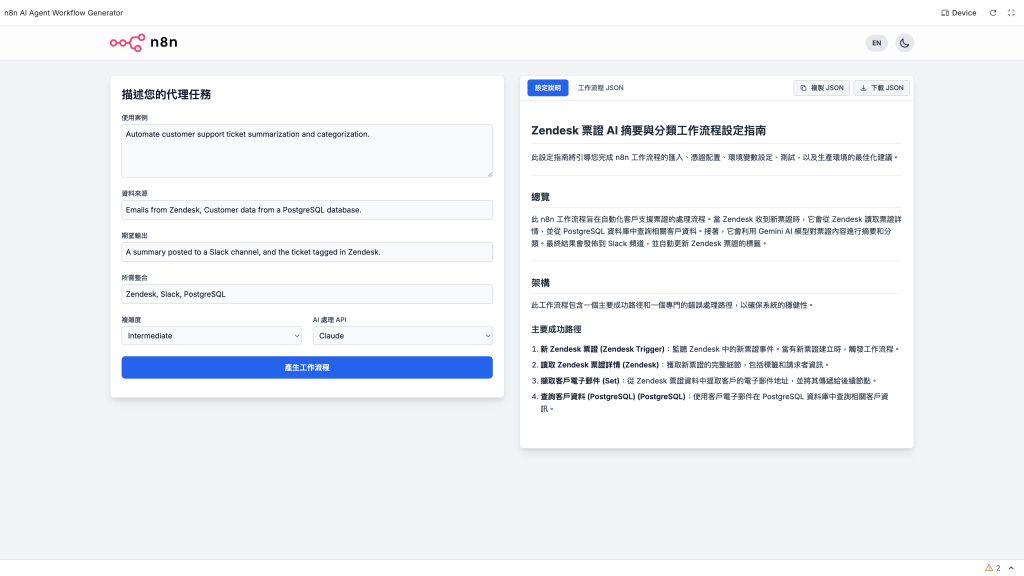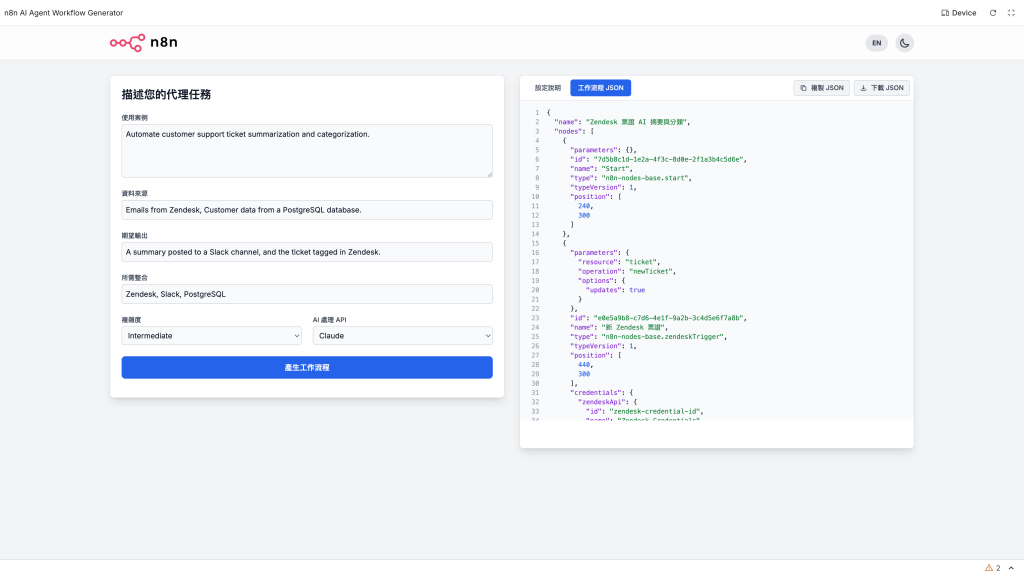隨著工作流程自動化的趨勢日益普及,許多人正尋求簡化日常任務的方法。對於 n8n 的初學者來說,掌握基本的設定與節點配置是實現自動化的關鍵。然而,面對複雜的流程需求時,常需要 AI 協作來共同設計解決方案。
因此,我發想了一個創新的工具:使用者只需輸入您的自動化需求,該工具便能即時生成初步完整的工作流程設定說明及對應的 JSON 檔案。使用者可以將此 JSON 文件直接匯入 n8n 中使用,並在此基礎上進行細部調整與優化,大幅加速從構思到實施的過程。
請你開發一個n8n agent workflow生成工具,根據下面提示詞去設計一個網站,當用戶輸入他的需求時候,可以根據他不同條件去生成json檔案以及如何在n8n執行的步驟。
You are an expert n8n workflow automation engineer with 5+ years of experience building production-grade AI agents. Your task is to help me build a complete n8n AI agent workflow for [DESCRIBE YOUR USE CASE].
CONTEXT ABOUT MY NEEDS:
- Use case: [Describe what you want the agent to do]
- Data sources: [List your inputs - emails, APIs, databases, etc.]
- Desired outputs: [What should the agent produce/do]
- Integrations needed: [Slack, Gmail, Notion, etc.]
- Complexity level: [Beginner/Intermediate/Advanced]
REQUIREMENTS:
1. Design the complete workflow architecture
2. Provide step-by-step n8n node configuration
3. Include error handling and retry logic
4. Add data validation and transformation steps
5. Suggest optimization for production use
DELIVERABLES I NEED:
□ Workflow diagram description
□ Complete node-by-node setup instructions
□ JSON workflow file structure
□ Testing and debugging checklist
□ Scaling recommendations
TECHNICAL SPECIFICATIONS:
- Use Claude/OpenAI API for AI processing
- Include webhook triggers where applicable
- Add proper data sanitization
- Implement logging for troubleshooting
- Follow n8n best practices for node naming
CONSTRAINTS:
- Keep it production-ready, not a demo
- Optimize for reliability over complexity
- Include fallback mechanisms
- Make it maintainable by someone else
EXAMPLES TO INCLUDE:
- Sample input/output data formats
- Common edge cases and solutions
- Performance benchmarks if relevant
STEP-BY-STEP FORMAT:
1. Architecture overview
2. Node sequence with configurations
3. Connection mappings between nodes
4. Environment variables needed
5. Deployment checklist
DELIVERABLES I NEED:
- Workflow diagram description
- Complete node-by-node setup instructions
- JSON workflow file structure
- Testing and debugging checklist
- Scaling recommendations
TECHNICAL SPECIFICATIONS:
- Use Claude/OpenAI API for AI processing
- Include webhook triggers where applicable
- Add proper data sanitization
- Implement logging for troubleshooting
- Follow n8n best practices for node naming
Start by asking clarifying questions about my specific use case, then provide the complete implementation plan.
左側的欄位是讓使用者定義和設定 AI Agent 任務的詳細資訊:
描述您的代理任務 (Agent Task Description):
Automate customer support ticket summarization and categorization. (自動化客戶支援工單的摘要和分類。)資料來源 (Data Sources):
Emails from Zendesk, Customer data from a PostgreSQL database. (來自 Zendesk 的電子郵件,以及來自 PostgreSQL 資料庫的客戶資料。)預定輸出 (Expected Output):
A summary posted to a Slack channel, and the ticket tagged in Zendesk. (一個摘要會發佈到 Slack 頻道,並且工單會在 Zendesk 中被標記。)所需資源 (Required Resources):
Zendesk, Slack, PostgreSQL (指明了這個工作流程會整合用到的三個主要服務或工具。)複雜程度 (Complexity) / AI 服務 (AI Service):
Intermediate (中等)Claude (使用 Claude 模型作為 AI 服務供應商。)右側區域顯示的是工作流程的中文說明,也可以切換到了工作流程的 JSON 程式碼。

右側的介面切換到了 "工作流程 JSON" 視圖,展示了工作流程的原始程式碼結構。
Start 節點和緊隨其後的 ZendeskTrigger 節點。這與中文說明中的第一步 "1. 新 Zendesk 票據觸發 (Zendesk Trigger)" 相符,確認了流程是由 Zendesk 的新工單事件所驅動。
這些圖片展示了使用者如何在 n8n 平台上利用 AI(可能是 Claude 或 Gemini)和資料庫(PostgreSQL)來建立一個整合多個服務的複雜自動化流程,用於高效處理客戶服務工單。
